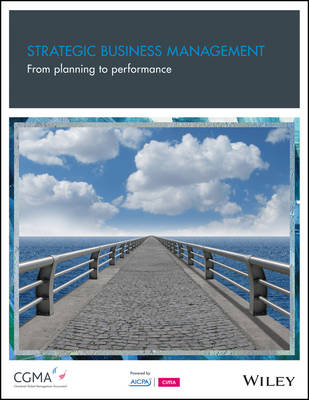
Strategic Business Management
American Institute of Certified Public Accountants (Verlag)
978-1-937352-35-6 (ISBN)
Author Gary Cokins uses his deep knowledge of the subject matter to deliver an easy-to-follow road map to effective and strategic management through: * Establishing the integral links between planning and performance * Demonstrating how risk management and performance assessment impact planning * Applying business analytics and Big Data in the finance and accounting functions as well as marketing, sales, operations and other functions * Evaluating the effectiveness of a strategy map and the balanced scorecard as a management tool * Tying budgeting to strategy and measuring the effectiveness of both via ongoing performance Written in a plain, straight-forward fashion that will allow you to draw immediate value from its content, this book pulls together several topics in an elegant, yet sophisticated approach, understandable to experienced and new managers alike. Strategic Business Management: From Planning to Performance is a must-have resource in any financial manager s office library.
Gary Cokins is an internationally recognized expert, speaker and author in advanced cost management and performance improvement systems. He is the founder of Analytics-Based Performance Management LLC. Gary began his career with Deloitte Consulting. Next with KPMG Peat Marwick, Gary was trained on ABC by Robert S. Kaplan and Robin Cooper. Gary headed the National Cost Management Consulting Services for Electronic Data Systems from 1996 to 2012 he was a Principal Consultant with SAS, a global leader in analytics software.
PART 1: OVERVIEW OF ENTERPRISE PERFORMANCE MANAGEMENT 1 1 INTRODUCTION 3 A Dilemma for Accountants 3 Accountants Problem of Denial 4 2 ENTERPRISE PERFORMANCE MANAGEMENT: MYTH OR REALITY? 5 Executive Pain A Major Force Creating Interest in Performance Management 6 What Is EPM? 7 Is EPM a New Methodology? 7 Clarifying What EPM Is Not 8 What Has Caused Interest in EPM? 9 The EPM Framework for Value Creation 10 The EPM as a Continuous Flow 12 A Car Analogy for EPM 13 Where Does Managerial Accounting Fit In? 14 EPM Unleashes the ROI From Information 15 Management s Quest for a Complete Solution 17 PART 2: MANAGERIAL ACCOUNTING 21 3 DO ACCOUNTANTS LEAD OR MISLEAD? 23 The Perils of Poor Navigation Equipment 23 The Perils of Poor Managerial Accounting 24 The Accountant as a Bad Navigator 24 4 A TAXONOMY OF ACCOUNTING AND COSTING METHODS 27 Confusion About Accounting Methods 27 A Historical Evolution of Managerial Accounting 29 An Accounting Framework and Taxonomy 29 Asking What? So What? Then What? 31 Predictive Versus Descriptive Accounting 32 Co-existing Cost Accounting Methods 33 5 MANAGERIAL ACCOUNTING DESIGN COMPLYING WITH THE CAUSALITY PRINCIPLE 35 Removing the Blindfold With ABC/M 35 Overhead Expenses Are Displacing Direct Expenses 36 Impact of Diversity in Products, Service Lines, Channels and Customers 37 Growing Discontent With Traditional Calculation of Costs 38 Activities Are Expressed With Action Verbs 39 Drivers Trigger the Workload Costs 41 Strategic Versus Operational ABC/M 42 6 STRATEGIC COST MANAGEMENT FOR PRODUCT PROFITABILITY ANALYSIS 45 ABC/M Is a Multi-Level Cost Re-assignment Network 45 Drivers: Resource, Cost, Activity and Cost Object Drivers 48 Business and Organisational Sustaining Costs 48 The Two Views of Costs: The Assignment View Versus the Process View 49 Vertical Axis 50 Horizontal Axis 50 How Does Activity-Based Costing Compute Better Accuracies? 51 Activity-Based Management Rapid Prototyping: Getting Quick and Accurate Results 53 Product Profitability Analysis 54 Two Alternative Equations for Costing Activities and Cost Objects 55 PART 3: STRATEGY MANAGEMENT 57 7 THE PROMISE AND PERILS OF THE BALANCED SCORECARD 59 What Is a Balanced Scorecard? 59 Balanced Scorecards Are Companions to Strategy Maps 60 Measurements Are More of a Social System Than a Technical One 62 Scorecard or Report Card? The Impact of Senior Management s Attitude 63 GPS Navigators for an Organisation 63 How Are Balanced Scorecards and Dashboards Different? 64 Scorecards and Dashboards Serve Different Purposes 65 Scorecards Link the Executives Strategy to Operations and the Budget 68 Dashboards Move the Scorecard s Dials 68 Strategy Is More Than Performing Better 68 Getting Past the Speed Bumps 69 8 DESIGNING A STRATEGY MAP AND BALANCED SCORECARD 71 Eight Steps to Create a Strategy Map 71 Scorecards and Strategy Maps: The Enabler for EPM 76 PART 4: PLANNING, BUDGETING AND FORECASTING 79 9 PREDICTIVE ACCOUNTING AND BUDGETING WITH MARGINAL EXPENSE ANALYSIS 81 What Is the Purpose of Management Accounting? 81 What Types of Decisions Are Made With Managerial Accounting Information? 82 Rationalisation 82 Planning and Budgeting 83 Capital Expense Justification 83 Make Versus Buy, and General Outsourcing Decisions 83 Process and Productivity Improvement 84 Activity-Based Cost Management as a Foundation for Predictive Accounting 84 Major Clue: Capacity Only Exists as a Resource 85 Predictive Accounting Involves Marginal Expense Calculations 86 Decomposing the Information Flows Figure 88 Framework to Compare and Contrast Expense Estimating Methods 90 Predictive Costing Is Modelling 91 Debates About Costing Methods 91 10 WHAT S BROKEN ABOUT BUDGETING? 95 The Evolutionary History of Budgets 96 A Sea Change in Accounting and Finance 98 The Financial Management Integrated Information Delivery Portal 99 11 PUT YOUR MONEY WHERE YOUR STRATEGY IS 101 A Budgeting Problem 101 Value Is Created From Projects and Initiatives, Not Strategic Objectives 103 Driver-Based Resource Capacity and Spending Planning 104 Including Risk Mitigation With a Risk Assessment Grid 105 Four Types of Budget Spending: Operational, Capital, Strategic and Risk 107 From a Static Annual Budget to Rolling Financial Forecasts 108 Managing Strategy Is Learnable 108 PART 5: INTEGRATING ENTERPRISE RISK MANAGEMENT AND ENTERPRISE PERFORMANCE MANAGEMENT 111 12 THE INTEGRATION OF ENTERPRISE RISK AND ENTERPRISE PERFORMANCE MANAGEMENT 113 How Do ERM and EPM Fit Together? 113 Is Risk an Opportunity or Hazard? 114 Problems Quantifying Risk and Its Consequences 114 Types of Risk Categories 115 Risk-Based EPM Framework 117 Risk Managers: Friend or Foe of Profit Growth? 118 Invulnerable Today but Aimless Tomorrow 119 PART 6: BUSINESS ANALYTICS FOR ACCOUNTING AND FINANCE 121 13 WHAT WILL BE THE NEXT NEW MANAGEMENT BREAKTHROUGH? 123 The History of Management Breakthroughs 123 Will Business Analytics Be the Next Breakthrough? 124 14 HOW DO BUSINESS INTELLIGENCE, BUSINESS ANALYTICS AND ENTERPRISE PERFORMANCE MANAGEMENT FIT TOGETHER? 127 The Relationship Between Business Intelligence, Business Analytics and Enterprise Performance Management 128 Overcoming Barriers 129 15 CFO TRENDS WITH ANALYTICS 131 Analytics as the Only Sustainable Competitive Advantage 131 Resistance to Change and Presumptions of Existing Capabilities 132 Evidence of Deficient Use of Business Analytics in Finance and Accounting 133 Sobering Indication of the Advances Still Needed by the CFO Function 134 Moving From Aspirations to Practice With Analytics 135 Customer Profitability Analysis to Take Actions 135 Rationalising and Validating Key Performance Indicators in a Strategy Map and Balanced Scorecard 136 Moving From Possibilities to Probabilities With Analytics 137 Fill in the Blanks: Which X Is Most Likely to Y? 139 Increased Employee Retention 139 Increased Customer Profitability 139 Increased Product Shelf Opportunity 139 The CFO Function Needs to Push the Envelope 140 PART 7: HOW TO BEGIN IMPLEMENTING ENTERPRISE PERFORMANCE MANAGEMENT 143 16 WHERE DO YOU BEGIN IMPLEMENTING ANALYTICS-BASED PERFORMANCE MANAGEMENT? 145 Accept That Analytics-Based EPM Is About Integration and Speed 145 Assuming an Enlightened Leadership Team, Then What? 146 Embrace Uncertainty With Predictive Analytics 147 17 A CALL TO ACTION BUILDING A BUSINESS CASE 149 The Obsession With ROI Justifications 149 Management and the IT Function Can Be Obstacles 150 Is EPM Art, Craft or Science? 151 Balancing a Smart, as Well as a Healthy, Organization 151 The Power of Business Analytics 152 The Future of Analytics-Based EPM 152
| Erscheinungsdatum | 15.12.2016 |
|---|---|
| Verlagsort | NC |
| Sprache | englisch |
| Maße | 216 x 275 mm |
| Gewicht | 478 g |
| Themenwelt | Wirtschaft ► Betriebswirtschaft / Management ► Rechnungswesen / Bilanzen |
| Wirtschaft ► Betriebswirtschaft / Management ► Unternehmensführung / Management | |
| ISBN-10 | 1-937352-35-8 / 1937352358 |
| ISBN-13 | 978-1-937352-35-6 / 9781937352356 |
| Zustand | Neuware |
| Informationen gemäß Produktsicherheitsverordnung (GPSR) | |
| Haben Sie eine Frage zum Produkt? |
aus dem Bereich


